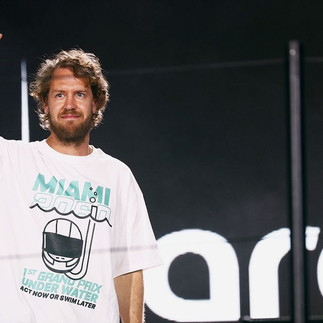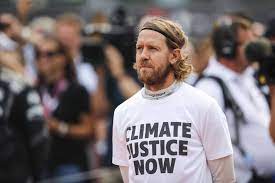Formula 1's Commercialization Could Accelerate Climate Change Advocacy. Here's how.
- Rasmika Rangarajan
- Jun 5, 2023
- 8 min read
Updated: Aug 13, 2023
Formula One. A brand, a business, and ‘the pinnacle of motorsport’. From being a brand that desperately needed sponsors in the early 2010s, to becoming a business that every big tech company wants to advertise in, F1’s rise has been phenomenal. Surprisingly, it wasn’t always sunshine and rainbows for the sport that’s now considered the highest tier of racing. For the longest time, it was thought of as the elite man’s sport and that wasn’t entirely untrue. Compared to sports like cricket, football and baseball; racing was incredibly inaccessible to most people. It’s important to keep in mind that within Europe itself, both F1 and the Indianapolis 500 (which was part of F1 for a brief period) were quickly rising in popularity. One could say that motorsport to Europe was like cricket to India - a fundamental part of their culture. Yet, there are a plethora of reasons why it wasn’t accessible.
Firstly, it isn’t a sport we conventionally see people participating in often as you might otherwise see children playing cricket in the neighborhood. You might have played football for your own school in your childhood but never tried go-karting. There’s then a gap in relatability and no inherent love that people held for racing, which is generally what draws people to other sports.
Secondly, there were several deals in the late 2000s that meant races wouldn’t be aired freely for the average viewer, tickets to races were expensive and a shift to V8 engines in 2014 that weren’t loud enough for the hardcore fans.
Thirdly, F1 itself remained stagnant, as they continued investing resources in securing bigger sponsors while the “new trend” back then was digital marketing. Youtube, Facebook, Instagram were rising in popularity and the formula for the sport to grow was laid out perfectly in the 2010s. Unfortunately, F1 did not get on the bandwagon and continued to decline until Liberty Media bought 100% of Delta Topco(F1’s then parent company) shares in 2017.
The Commercialization of F1
The new owners not only brought the sport out of the shadow it had been in, but also brought with them an evolved marketing strategy. This meant uploading official race highlights, driver briefings, interviews and more to the F1 Youtube channel so that fans around the globe were simply a click away from delving deep into the sport.
Like any other sport, the players or rather the drivers themselves were a big part of reeling in new fans. Arguably one driver, Lewis Hamilton, quickly became the face of the sport and being the only black driver in Formula 1 history, he had a novel perspective of rising from the bottom to the pinnacle of F1 which was close to the hearts of a lot of people of color. F1, now catered to a wider demographic of people and thus we slowly saw a Euro centric sport morphing into a global sensation enjoyed by millions. One cannot forget that Hamilton’s presence attracted a range of celebrities from various fields into the paddock for race weekends. Be it fellow athletes like Serena Williams, Maria Sharapova; models like Gigi Hadid, singers like Christina Aguilera or actors like Will Smith; Lewis seemed to be friends with them all. The spotlight was on F1 as fans of these celebrities were interested in learning more about races too.
This is where the Netflix documentary style series ‘Drive to Survive’ comes in. F1 struck a goldmine when they partnered with Netflix to create something which was an easy starting point for anyone who wanted to get into the world of F1, and proved more accessible than ever as it was simply a click away. Like drivers’ qualifying laps, the timing of this partnership was impeccable as it coincided with the rise of video streaming platforms that were becoming an irreplaceable part of every household.
These 3 major factors, paired with several others like the increased advertising of merchandise and digital marketing strategies were fundamental/ cardinal in commercializing the sport. Sure, commercialization meant celebrities and influencers who had never watched a single race taking up more space in races, higher ticket prices for fans and cringy driver parades that no one could bear(See, Miami Driver Parade). Yet, this commercialization is exactly what’s keeping F1 in a league of its own, without any shortage of money as it’s part of a virtuous cycle. That is, as the sport becomes more popular, this in turn means more hotshots like Amazon or Chrome want to advertise on F1 cars that again provides a greater reach for F1. This is uniquely why F1 can be hugely beneficial for social justice because whether we like it or not, ‘cash is king’ even when it comes to issues of fighting racism, climate change and what not.
What F1 has already achieved when it comes to social justice
Simply throwing money at the problem isn’t the solution but combined with the right intentions, this would be the perfect combination in combating issues of social justice. At this, Formula 1 is no rookie, since they’ve had several campaigns such as #WeRaceAsOne to fight against global inequality, the goal to go carbon neutral by 2030, and the drivers speaking out against the war incited by Russia in 2022(which quickly made one forget how Haas F1 was funded by Russian oligarchs). There are individual teams such as Mercedes which are indeed the trailblazers as the opted for a black livery in 2020 in light of the #BlackLivesMatter movement and in support of George Floyd.
One has to credit Lewis Hamilton here, as he was a pioneer in bringing issues of social justice into the sport and using his platform to help draw attention to issues of racism and whatnot. He took the knee in 2020, and sported the colors of the rainbow on his helmet even during races in Qatar in 2021 where homosexuality is criminalized till date. He has launched an initiative, ‘Mission 44’ to empower people of color from a young age and help them access opportunities in STEM based careers. Lewis isn’t the only driver making changes, Sebastian Vettel(the Weltmeister from Germany) sparked a debate on the climate crisis amidst the motorsport community when he sported a t-shirt with the text “MIAMI 2060: 1ST GRAND PRIX UNDER WATER: ACT NOW OR SWIM LATER” at the Miami Grand Prix in 2022.
A Case Study : The Emilia Romagna GP
Seb was right, except it was the Imola Grand Prix underwater in 2023 due to floods in the Emilia Romagna region. The heavy rainfall caused 400 landslides and cost the lives of thousands. This wasn’t an isolated incident but the effect of the region becoming a climate change hotspot. One of the reasons this event received more airtime can be attributed to the popularity of F1 and the fact that this was a highly anticipated race, the Imola GP being Ferrari’s home race. F1 auctioned the Imola GP’s trophies and signed merchandise to raise funds for the displaced individuals after the tragedy. Yuki Tsunoda, an F1 driver for Alphatauri, himself helped clean up the debris laden streets struck hard by the floods. This action of his not only directly helped the displaced individuals but created lots of awareness about the dire situation. Charles Leclerc, had a charity auction which raised a whopping £368,800. The items bid for were the fan-favorite Monegasque's one-off helmet in his home race's colors, his racing suit, boots and gloves. This is the highest price that an F1 helmet has been bid for and sold, which sets a new record which was earlier held by the beloved Brazilian champion Ayrton Senna. It's this money that's changing lives for the many displaced in Imola. Every driver used their social media platforms to raise awareness and clearly the F1 family was successful because the end result was a donation of £870,000 plus food and water for the flood relief efforts in Imola.
Why F1 is a game changer for the future of climate change
Awareness : This case study shows us the stellar reach the sport has in matters outside of thrilling racing and entertainment alone. Passionate fans who might not care about the environment change their minds when it’s their favorite racing circuit that’s submerged or it’s their idol who wants them to donate for the cause. More people who were previously unaware, realize the gravity of the situation and that the idea of melting ice caps isn’t a century away but the status quo. This sort of widespread awareness can singularly be achieved with a commercialized sport like Formula One, which is viewed by a diverse group of people, be it teens or senior citizens, in Monaco or India, who now know much more about the environment than before.
Research & Innovation : Notably, F1 employs some of the best minds from STEM and world class engineers, who could add a fresh perspective to the way we build EVs. Unlike other sports which could create awareness about climate change, these scientific minds in motorsport are the reason F1 could actually impact the climate movement in terms of novel innovations in the direction of sustainability.
Current Developments - Santander is working with Shell as Mercedes is with Petronas to develop newer types of fuel that leave a smaller carbon footprint. Santander and F1 have an agreement that’d introduce a 100% sustainable fuel by 2026. These fuels can’t directly be used in road cars which use fuels of lower octane levels(these are more combustible compared to the unleaded petrol used by F1 that has a higher octane level of 95-102), yet the basal concepts used and compounds created can certainly be cross applied to road cars.
Mercedes has invested in sustainable aviation fuel as well which is something their partner Petronas has been developing. This shows us how we can cross apply a lot of the R&D that F1 has done to make the sport more sustainable. There are existing tie-ups which could prove useful in the future, since we have prominent luxury car brands in F1 like Mercedes, Mclaren, Ferrari, Aston Martin and Alfa Romeo
A robust budget : They clearly have deep pockets and funding is crucial as we transition into a time that needs more innovation than ever to mitigate the effects of climate change and help those across the world who face the brunt of its effects. It’s not just F1, but its sponsors which include lots of companies that want to be perceived as eco friendly rather than as an evil, ‘climate change isn’t real’, corporation like ExxonMobil. Frankly, being environmentally conscious is what they need in order to maintain a sustainable profit model as we march into a future with higher temperatures than ever, unpredictable floods, earthquakes, and whatnot.
Accountability : Formula 1 cannot simply advocate for all this, and get away without making rudimentary changes in their functioning. Fame works both ways, and that’s why there’s more scrutiny regarding the energy inefficient flight schedule they currently have. Especially when they’ve been advertising around the goal of going carbon neutral by 2030 for so long, it’ll be a dire hit to their reputation if they don’t live up to the bar they set for themselves.
For instance, Mercedes is using HVO 100(Hydrotreated Vegetable Oil), a 100% renewable biofuel for their trucks that transport equipment between the circuits Spa Francorchamps, Zandvoort and Monza as they try to achieve a 60% reduction in emissions.
Ultimately, more changes like this will take plenty of time and it’s not going to be easy adapting to all this for a sport that’s heavily been reliant on petrol for decades now. Yet, if all the factors above work in our favor, F1 could be the trailblazer as we transition to be more eco-friendly in the future. But for a sport that’s not traditionally perceived as the most energy efficient, a lot of F1’s achievements and goals intersect with the climate movement’s wider goal for tackling the environmental crisis we find ourselves in.

























Looks like you’re an ardent follower of the sport. Fantastic research. 👍
Really a stunning write up ! Such indepth research and coherent articulation . You do not sound like a novice at all Rasmika . The vivid explanation is astounding and very professional .
Best wishes and way to go! Looking forward to more such .
Vaijayanthi krishnan
Excellent article! Really liked the way u set the context and structured the story from the evolution of the sport to its impact on the much talked about topic of sustainability
Stunning. Your indepth knowledge, hours of research to collect various events/facts and collate them, precisely driving home your thoughts on the subject coherently are amazing and incredible🤝👏
Loved reading. It gives the basic knowledge and understanding about the topic to the layman also. Very coherent write-up.